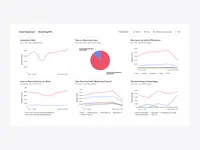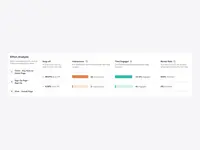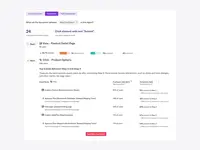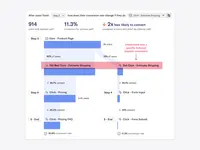Overview
What is Heap?
Heap is a web analytics platform captures every user interaction on web iOS with no extra code. The tool allows you to track events and set up funnels to understand user flow and dropoff. It also provides visualization tools to…
The collection and processing of data is automated.
Solid Data Tool
Heap : Simplified Customer Analytics for Dummies
An essential tool for studying user behavior!
Heap - Insights in the digital world
Auto-capture every user interaction with no manual event tracking. No messy tracking plans. No custom ETL pipelines
We use Heap to auto-capture every user interaction in our website. it used by the product and …
power of AI/ML meets with Best UI/UX to deliver optimal ROI
Great Platform to generate User Interaction data and gather actionable Insights
Heap Product analytics
Robust software with great analytical capabilities
great automated data collection.
Heap Review
So we are …
Good product
Heap - a great Digital Insight Platform
Heap: Identify your website logical path to improve sales.
Awards
Products that are considered exceptional by their customers based on a variety of criteria win TrustRadius awards. Learn more about the types of TrustRadius awards to make the best purchase decision. More about TrustRadius Awards
Pricing
Free
$0
Growth
Starting at $3,600 annually
Pro
Contact Heap Sales
Entry-level set up fee?
- Setup fee optional
Offerings
- Free Trial
- Free/Freemium Version
- Premium Consulting/Integration Services
Product Demos
Fibonacci Heap Demo
Imogen Heap Performance with Musical Gloves Demo
PANASONIC - BREAD MAKER (SD-P104) - (DEMO) BY HEAP SENG GROUP
HAPPYCALL - 'DIAMOND' DOUBLE PAN (DEMO) BY HEAP SENG GROUP
Heap: A Smarter Approach to Product
The Gloves Music Controller Demo with Imogen Heap | Digital Transformation
Product Details
- About
- Integrations
- Competitors
- Tech Details
- Downloadables
- FAQs
What is Heap?
- Improve customer experience: Pinpoint exactly where users are struggling and make improvements to the customer experience, driving an intuitive, enjoyable user experience.
- Speed time-to-market and optimize the impact of product and business teams: Rather than relying purely on gut instinct, leverage digital engagement data to test hypotheses and answer questions as they arise. With data-driven insights, confidently bring new features & experiences to market.
- Build increasingly valuable features and experiences: Leverage data to build consensus on engineering investments that can be clearly tied to business outcomes.
Heap Features
- Supported: Autocapture (Codelessly capture every interaction/event in a product or website)
- Supported: Event Visualizer (Locate, tag and name events with this tool)
- Supported: Data Engine (Data Dictionary and Governance tools provide control and organization of data)
- Supported: APIs (Augment data with flexible APIs)
- Supported: Sources (Import data from other tools)
- Supported: Reporting and Dashboards (Get insights on activation, retention, conversion, engagement and other key digital/product metrics)
- Supported: Ad-hoc Analysis (Retention, Conversion, Funnel, Cohort analysis, etc)
- Supported: Heap Connect (Bring user data with managed ETL into warehouses such as Snowflake, Redshift)
- Supported: Heap Activate (Drive action base on Heap data via connectors to Appcues, Marketo, Intercom, and Salesforce)
Heap Screenshots
Heap Videos
Watch Heap - A Smarter Approach to Product. What is Heap and how does it work?
Watch Customer story: Northwestern Mutual becomes data-driven with Heap
Watch Customer story: Snapfish Uses Heap’s Omni-Channel Tracking to Increase Conversions
Watch Customer story: E*TRADE's analytics team delivers insights with Heap
Heap Integrations
Heap Competitors
Heap Technical Details
| Deployment Types | Software as a Service (SaaS), Cloud, or Web-Based |
|---|---|
| Operating Systems | Unspecified |
| Mobile Application | No |
| Supported Countries | Americas, EMEA, APAC |
| Supported Languages | English |
Heap Downloadables
- Product Analytics Buyer’s Guide: A guide to choosing the right product analytics solution
- Heap's Digital Experience Insights Report: How to Miss Everything About Your Users (And How Not To)
- Digital Insights Are a Superpower: A comic book about how to use data to transform your customer experience
- Heap's 3 Templates for Uncomplicating Product Management: Bring your Product Management processes into the future with structure and a shared knowledge base
- Using Digital Analytics to Drive Business Outcomes: How to Align People, Process, and Technology
Frequently Asked Questions
Heap Customer Size Distribution
| Consumers | 0% |
|---|---|
| Small Businesses (1-50 employees) | 40% |
| Mid-Size Companies (51-500 employees) | 40% |
| Enterprises (more than 500 employees) | 20% |
Comparisons
Compare with
Reviews and Ratings
(382)Community Insights
- Business Problems Solved
- Pros
- Cons
- Recommendations
Heap is a highly versatile analytics platform that has been widely used by organizations to collect and analyze customer data. Users have found Heap to be a powerful tool for automatically tracking customer behavior and understanding their journey. From keeping metrics in check and tracking against key performance indicators, Heap has proved its effectiveness. It has helped teams track the performance of newly released features, identify areas for improvement, and understand both user and system behavior of applications.
Heap has been valuable in enhancing the understanding of customer behavior, improving user engagement, identifying pain points, and mapping out the user journey. It enables organizations to validate hypotheses, pilot test new features, and determine the success of those features. Users appreciate how Heap helps them identify issues in the user experience, summarize interactions, and ultimately improve the overall user experience. By delving into customers' digital journeys, Heap allows companies to better design processes, increase platform usage, and pinpoint areas of easiness and difficulty for customers.
In addition to these applications, Heap serves as a powerful tool for tracking and analyzing user interactions, determining adoption and usage statistics, segmenting users into multiple buckets, verifying default assumptions, locating friction points in processes, building customers' digital journey, creating graphs and charts for analysis in various industries such as healthcare and finance. Heap also supports funnel optimization by providing insights into drop-off points and channel performance. Whether it's the product team making data-driven decisions or marketing personnel measuring traffic sources and conversions, Heap offers valuable analytics data across different functions within organizations.
Overall, users rely on Heap to gain deep insights into user behavior, make informed business decisions, improve user experience based on audience segments, track conversion rates and usage patterns, measure product performance against competitors. It helps understand customer engagement with websites or apps, extract insights on users' tendencies within pages or forms. It evaluates clicks and funnels while monitoring various metrics such as conversions, page views, enrollment rates, etc. Heap's ability to provide comprehensive data analyses, flexible tracking capabilities, and valuable input for product decisions has made it an essential analytics tool for companies seeking to improve their understanding of customer behavior and drive business growth.
Intuitive and User-Friendly Interface: Users have consistently praised Heap for its intuitive and user-friendly interface. It has been mentioned by many reviewers that the interface makes navigation and task completion easy.
Highly Praised Event Visualizer Tool: The event visualizer tool in Heap has received high praise from users for simplifying the process of defining elements to track engagement without the need for additional coding. Several reviewers have highlighted this feature as a standout aspect of the platform.
Auto-Capture Feature: Many users appreciate Heap's auto-capture feature, which automatically records all events on their website. This eliminates the need for manual tracking and saves valuable time for businesses. The convenience provided by this feature has been highly regarded by multiple reviewers.
Confusing User Interface: Several users have expressed frustration with the user interface, particularly when it comes to defining reports. They feel that the current approach is confusing and suggest a simpler and more intuitive design.
Difficulties with Filtering and Group-by Selection: A number of users have encountered difficulties while filtering events in the graph report. Additionally, they mention that the group-by selection often gets reset in funnel reports, causing inconvenience and extra effort.
Steep Learning Curve: Users have found the learning curve for using the platform to be steep. Many feel that technical knowledge is required to use it proficiently, which can be a barrier for non-technical or less experienced users.
- Implement Heap as soon as possible to start capturing all analytics and defining events easily. Prioritize creating a data strategy beforehand, including key performance indicators (KPIs) and meaningful analytics for the organization.
- Complement Heap with other analytics tools to cover everything not planned for in regular analytics. Consider using Heap as a separate tracking system compared to traditional tools like Omniture or Google Analytics.
- Thoroughly learn the documentation of Heap to fully utilize its capabilities. Do not hesitate to reach out to Heap support for assistance with any questions that arise.
Users also find Heap valuable for understanding user behavior, making data-oriented decisions, and improving products. They appreciate its ability to capture all analytics and save time by enabling more employees to build out analytics.
Attribute Ratings
Reviews
(1-25 of 36)Heap Product analytics
- Very easy to build quick dashboards for analysis- just a matter of minutes
- Events can be tracked in near real-time ,without any latency
- High support for self-serve with deep level of documentation
- Intuitive platform with quick learning; no formal training needed for user adoption
- Mobile version is suboptimal without flutter support
- Graph analysis is very basic and sometimes calls for csv download for detailed analysis
- Initial event and platform configurations are too detailed and clumsy
Heap: Identify your website logical path to improve sales.
- The path from website landing until the sale success.
- Identify the possible broken logical path that is avoiding the sale success.
- Machine Learning to identify the customer navigation trends in your website.
- Measuring of website performance to see if the server is deliving content fast.
- Machine learning time series of customer visits.
- Grouping statistics to identify geographically the website sales.
Get Answers to Your Questions, Fast!
- The event visualizer allows you to easily create events by browsing your website and clicking on elements.
- [It's] very easy to onboard new users and to start getting value out of it.
- [It] provides contextual tips [on] how to best look at your data to get the answer that you need.
- Sometimes you can get confused about which filter you can and can't use depending on how you chose to look at your data.
Heap is helping us to scale our startup quick!
- Behavior Tracking.
- Segmentation.
- Trend Analysis.
- Better walkthroughs.
- Wider Integration Options.
- More frequent syncs with integrations.
From a product designer's perspective.
- I love the customization that Heap allows in creating dashboards.
- I enjoy the collaborative data points that all can reference in their dashboards.
- I love the clean UI of Heap, making data beautiful!
- I think Heap can improve its onboarding; I would love to see some info that is helpful for someone who isn't in Heap every single day.
- Sharing dashboards can be tricky, it feels like a huge learning curve that I already have forgotten how to do.
too much of learning curve for nonexperts to engage with heap, dosen't get used in the org how we'd like it too
- display segments on graphs
- suggest events
- visual labelling
- discoverability of events, taxonomy of events, management of events. If i didn't set them up it's incredibly hard to find the right ones, verify what they are etc.
- just make it easy for me to paste a URL and see some stats please. I have to define a graph, set the unique view count and then enter the path. That is so labrious for something that feels like it should be easy
- customisation and consistency of graph colours across multiple reports. For example if we're looking at multiple graphs segemented by marketing channel I'd like email to be the same colour on each graph.
HEAP is great for customer success orgs
- Locate information gap
- Analyze large amounts of information
- Display in visuals so easy to understand
- More filtering
- More visuals to present
- Able to download as PDF
- Easy way to define events without engineers.
- Simple interface and intuitive UI/UX.
- Cheaper than other high end analytics tools.
- More accurate tracking when doing visual labelling.
- Events management after they are defined.
- Integrations with other platforms.
Heap for design teams.
- Analyse user flows and interactions.
- Create powerful reports and dashboards for sharing quantitative data.
- Help with analysing data.
- Better learning material with more video lessons when possible.
- Learning material in other languages.
Heap review
- User journey - sign up flow
- Where the drop off happens
- Learning curve for Heap is deep.
Heap Review
- Tracking number of users coming on specific pages
- Dividing users into different segments
- Understand the user journey of customers on the website
- Adding functionality where we can automate definition creation
- Creating more lectures which would help users already existing functionality
- Some more ways to audit multiple definitions at once
Some room for improvement, but overall okay!
- Track individual events
- Track individual movements
- Provide reporting dashboards that can be shared across users and departments.
- The learning curve is steep - I've watched multiple trainings and still have major problems navigating and figuring out how to do what I want to achieve
- Data is presented poorly - there needs to be more options for chart displays and overall dashboards (Salesforce does this well)
- Once an event is defined by a user, it's not easy to find, so the same event is defined multiple times across multiple users.
Easy to use for non-technical people
- Analyze usage of specific components
- Allow tracking data retrospectively
- Easy to define events
- Bulk editing category of events
- Switching between different products
Heap Advanced Analytics
- Data validation
- User management and permissions
- Backfixing data and segmentation
- Providing very flexible but granular data
- Somewhat buggy visual labeling of events functionality
- Training courses / Heap University is outdated
- Training in general / use case examples
Powerful but difficult to use. Lots of potential!
- Help me understand the usage of certain areas of my platform
- Gather extra information via custom events
- Define events that I want to keep tabs on
- The event visualizer is very slow and a bit confusing
- Shared (public) metrics are a mess. I find it difficult to easily determine if an area I'm interested in is tracked
- When creating an event, it's annoying to have to fill out all the filters when you're tracking something that is similar to an existing event (Perhaps something like event profiles could make it easy to get the event 90% to completion).
- I don't know of anyone that has evergreen heap reports. Most of our use cases are for ad-hoc experiments or deep dives.
Excellent analytics tool with lots of potentials
- Flexible event definition
- Wide range of integrations
- Funnel analysis
- Identity API
- Limited logic filters within reports
- Fairly steep learning curve
- Attribution modeling
- Event Visualizer can be improved
A conversion rate optimization must!
- Analyze Funnels
- Quickly define key events on a website
- Produce graphs seamlessly
- Use case tutorial videos
Heap is okay
- Somewhat intuitive interface
- Realtime reports
- Custom defined events and conversions
- Attribution modeling
- Faster loading of data
- Easier segmentations
The most efficient way to make your site more efficient
- Track a user over time.
- Highlight differences between desktop and mobile behavior.
- Identify the most common path from point A to point B.
- Multi-touch attribution modeling.
- Identifying the referrer for a particular user or session.
- Registering the full impact of paid ads.
Heap Auto-Capture Is a Game-Changer
- Auto-captures data , even before you define it
- Event definition makes it easy to define events for reporting
- Robust reporting tool
- Rather steep leaning curve
- Highly customizable but also can overwhelm users with options
Still Learning the Tool but Find It to Be a Little Difficult!
- Data visualization
- Organization of dashboards
- Simplicity
- Overviews of audience
- Data aggregation
- Easier to share information across teams
- Ability to create PDF reports for leadership
Heap Experience
- Investigate questions
- Provide support
- Show results to others
- Can be difficult to understand how to use.
- Can be difficult to implement; implementation team was a bit lacking.
A Hassle Free, Fast, and Great Product Analytics Software
- From the time we have been using this we have become much more confident in [the] analysis of data.
- Analyzing the front-end in the event data is a great feature.
- Moreover, the way the event data gets automatically captured is also a great advantage.
- The software is known for its services in Web Analytics and Product Analytics.
- On the other hand, I think that the tool should have a better onboarding experience because it's currently not up to the mark [in my opinion].
- [I believe] there is currently quite a steep learning curve which also needs to be improved and made better because users are not too happy with steep learning curves.
- I sometimes felt that data governance plays an integral role in the functionality of the tool because without it everything just becomes so noisy so I think that this should also be looked into consideration.
Fantastic software to help you improve your user experience.
- It is really good at auto capturing events, that automation reduces your workload a lot.
- It is really simple to create and export reports.
- Detailed dashboard that includes everything you would need at a glance.
- Our Development Team found the API really simple to use as well.
- There is a learning curve. If you are using this for the first time, it will take some getting used to. It can overwhelm you with data.
Still learning, but great so far
- User friendly.
- Modern tech.
- Tutorials.
- Deeper dive on event definitions.
- Integrations with Optimizely - more detailed overviews of how it works.









